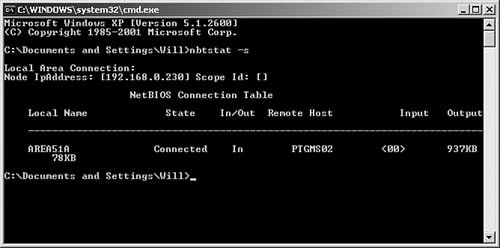Client Tools
| A thorough understanding of WINS and server-based resolutions is great, but it won't help diagnose problems on a client. The tools discussed in the following sectionsnbtstat, ipconfig, and netdiagare helpful in resolving name resolution problems. nbtstatNBT stands for NetBIOS over TCP/IP. Thus, nbtstat gives you statistics for NetBIOS over TCP/IP. The utility is used to determine which NetBIOS names the machine has cached and to which IP addresses those names resolved. You need to be aware of the options for using the nbtstat, as outlined in Table 4.1.
Figure 4.22. nbtstat -a shows the machine's NetBIOS table. Figure 4.23. nbtstat -c shows the local NetBIOS cache. Figure 4.24. nbtstat -s shows the current NetBIOS sessions. ipconfigPerhaps the most widely used TCP/IP utility is the ipconfig utility. It is the only way to display all the dynamic information retrieved from a DHCP server. It also allows you to update DHCP and name resolution information. ipconfig is the primary utility you will use when attempting to diagnose and fix IP configuration problems, and it was discussed in depth in Chapter 1. Exam Alert: ipconfig Know the options for the ipconfig utility, and, more importantly, know what they do. You'll be expected to know which option to use in a given situation. netdiagUnlike the other tools discussed in this chapter, netdiag is not included as a part of the standard Windows Server 2003 installation. To install neTDiag, you must install the Windows Server 2003 Support tools or download it as a separate update. The netdiag utility is available from the Microsoft Web site for free. For the exam, you need to know that the netdiag tool is used to diagnose all types of connectivity problems. It automatically runs a series of tests to help you determine where your connectivity problems lay. Note: netdiag You can get more information about the Windows Server 2003 SP1 Support Tools by visiting the following Knowledge Base article: http://support.microsoft.com/kb/892777. This article also provides a link to the download. Alternatively, you can find the Windows Server 2003 Support Tools on your Windows Server 2003 product CD; it's the file named suptools.msi located in the "\SUPPORT\TOOLS" folder. |
EAN: 2147483647
Pages: 196